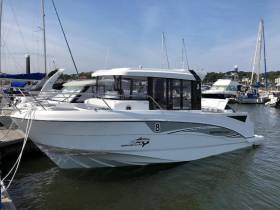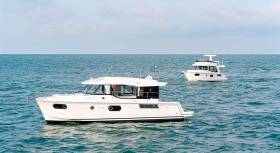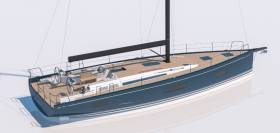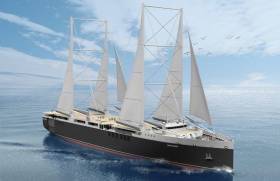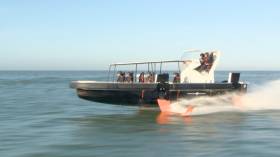Displaying items by tag: Beneteau
Off the back of what they declare was their best ever year for sales of Beneteau outboard boats, Irish brokers BJ Marine were recently in attendance at the French builder’s global dealer conference in Valencia to get a special look at its fully Suzuki-powered range.
General manager James Kirwan told Afloat.ie: “The growth of the range of outboard boats inspired us to invest in our first ever Irish Barracuda Tour qualifier, an event that also supported by Viking Marine, our Suzuki partner in Ireland.”
Beneteau’s outboard range covers the Antares, Barracuda and Flyer models, from six metres up to the new Antares 11 which will be unveiled this winter.
“In particular, the Antares and Barracuda ranges offer the perfect versatility for use in Irish waters where rapidly changing weather and sea states are regular events,” Kirwan said.
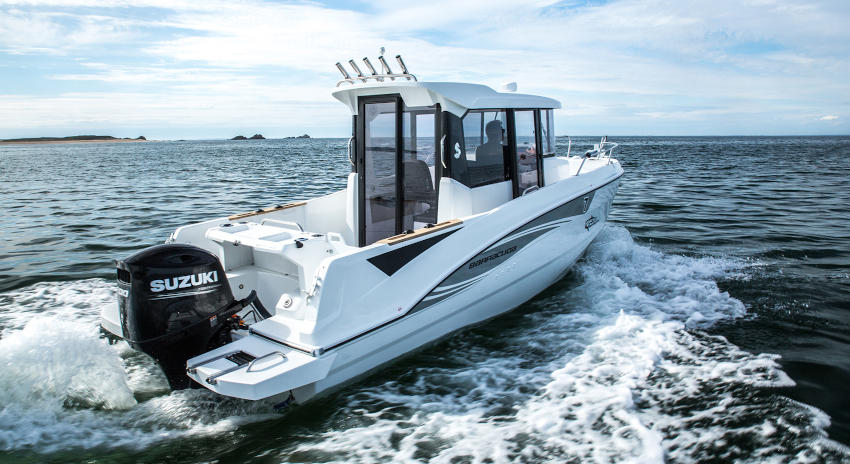 Beneteau Barracuda with a Suzuki DF200AP outboard
Beneteau Barracuda with a Suzuki DF200AP outboard
Suzuki has been the outboard supplier of choice for Beneteau since 2013 and the French builder says its partnership continues to go from strength to strength.
Five Suzuki-powered boats were on the water in Valencia ready for dealers to test — including the new Flyer 10 and 7.
“We are very proud to work with and partner Beneteau,” said Daisuke Kawatari, general manager for Suzuki Motor Corporation’s European liaison office.
“Our partnership is a strong one and we are looking forward to taking it to the next level in order to continue to deliver the ultimate boat/engine packages for our customers.”
Beneteau’s New Swift Trawler 41 Is An Exciting Prospect
Irish Beneteau dealers BJ Marine are looking forward to the arrival of the new Swift Trawler 41.
The Swift Trawler range has been one of the most successful in Irish waters, says BJ Marine’s James Kirwan, especially the original 42 and the 44.
This latest and final addition to the successful range of long-distance cruisers is 13.3 metres long with a 4.2 metre beam, combining seaworthiness with living space and comfort, and inherits the contemporary feel — and optimised hull design — of last year’s Swift Trawler 47.
Famed for stability and economy, the Swift Trawler has been particularly popular for sailors who are looking to take a step away from sailing and move to power.
What is incredibly exciting about the new 41 is the amount of accommodation that they have managed to pack in to the boat — up to seven passengers — as well as the option of the Sedan for our climate at home when the flybridge can sometimes be under-utilised.
James will be aboard the boat in two weeks for trials and will come back with a full report that will be of particular interest to existing Swift Trawler owners and those looking to crossover from sailing, as the Swift Trawler range always provides the answer to their needs.
Hervé Gastinel Steps Down As Groupe Beneteau Chief Executive
International Boat Industry is reporting that Hervé Gastinel has stepped down as chief executive of Groupe Beneteau with immediate effect.
Gastinel, who was CEO of the French boatbuilding group since 2015, has been replaced by Beneteau chairman Jérôme de Metz.
The move comes with a number of changes in the management board of the group’s boat division — and follows changes at other high-profile boatbuilders Sunseeker and Princess in the past week. IBI has more on the story HERE.
Beneteau is prepping for the unveiling of its new First Yacht 53 in September at Cannes, where Irish Beneteau agents BJ Marine will also have a presence.
After two years of development, Beneteau’s First Yacht 53 will be shown for the first time at the Cannes Yachting Festival this September, followed by autumn boat shows in Genoa, Barcelona and in the US at Annapolis.
The 17-metre yacht — with a hull designed by America’s Cup veteran Roberto Biscontini and interior/exterior stylings by Lorenzo Argento — is a performance-ready vessel that aims for excellence in fast, comfortable sailing to meet the expectations of the most demanding sailors, according to the French luxury yacht marque.
Featuring a full plumb bow and a maximum beam further aft, the twin rudders promise perfect feedback to control the highly responsive hull.
The 2.5m or 3m draught (with lead bulb), as well as an optional carbon mast, are intended to give the First Yacht 53 the competitive advantage to clock up miles quickly.
“To achieve maximum thrills at the helm, we focused on balancing weight and balance under sail when we designed the boat,” Beneteau explains.
“We worked hard to optimise the position of the centre of buoyancy in relation to the centre of effort, guaranteeing a lively yacht under sail, responding quickly to the helm.”
Beneath asked “the best outfitters” to provide their top-performing products: North Sails for the sails, Harken for the deck gear, Lorima for the mast and Lemer for the keel. All were involved on the recent design of the Figaro Beneteau 3 with foils.
Upgrades for this newest in the First range include improved deck circulation with a layout emphasising the experience above deck, and a hull built using the infusion process.
“I have always looked for performance on the boats that I sail and build. The First Yacht 53 is a lot like me!” Biscontini says.
Beneteau yachts are distributed in Ireland by BJ Marine, which will be at Cannes to see the launch of the French marque’s other new arrival, the ‘Smart Luxury’ generation Monte Carlo 52.
Beneteau’s new Monte Carlo 52 will have its official launch in September at the Cannes Yachting Festival.
But the French marque has already offered a taste of what to expect from the new ‘Smart Luxury’ generation of Monte Carlo motor yachts.
The French-built “elegant contemporary cruiser” is over 16 metres long with a 4.6 metre beam and “boasts enhanced spaces, light and comfort” in its world-class design — courtesy of Carlo Nuvolari and Dan Lenard (exterior line) and Andréani Design (interior accomodation), with a V-hull designed in partnership with MICAD.
Beneteau adds: “The Monte Carlo 52 is an exclusive motor yacht, yet her value for money outstrips similar luxury cruisers on the market.”
The Monte Carlo 52 will be available for exclusive trials this summer on the Mediterranean; at Beneteau’s new base in Port Ginesta, near Barcelona; and also visible at dealers such as BJ Marine, Ireland’s Beneteau distributors.
James Kirwan, general manager of BJ Marine, says the announcement has been “eagerly awaited”.
“It really completes the inboard motor boat offering from Beneteau, alongside the Swift Trawler and Gran Turismo ranges”
Kirwan says BJ Marine will experience the Monte Carlo 52 first-hand in a fortnight’s time — and notes that a number of clients have already expressed interested.
“Its combination of style and stability makes it ideal for Irish boaters at home or further afield,” he adds.
New Wind-Powered Shipping Concept Makes A Sail With Beneteau
Groupe Beneteau has confirmed its interest in a project that’s developing a revolutionary method of wind-powered cargo shipping.
The French maker of top-range sailing yachts said the NEOLINE project was “a natural choice” for transporting its exports from Europe to the North American market, which represents nearly a third of its revenues.
“The exceptional dimensions of our boats and the need to safeguard their quality at every stage during their transportation makes this flow a real logistics challenge,” said Magdeleine Allaume, procurement and supply chain director with Groups Beneteau.
“NEOLINE offers a bespoke solution that is ecologically and economically relevant for our transatlantic flows, with loading also located very close to our yards.
“As the world’s leading builder of recreational sailing yachts, the use of sails for maritime transportation, effectively put in place with the NEOLINE project, was a natural choice for us.”
NEOLINE is developing “an industrial-scale freight transportation solution” that is powered primarily by sails.
The project’s first goal is the Neoliner, a 135m RORO vessel with 4,200 square metres of sails which will make it possible to reduce C02 emissions by up to 90% compared to a traditional cargo ship on an equivalent route.
NEOLINE aims to have its first two ships based on this model commissioned by 2021 on a pilot route connecting Saint-Nazaire in France to America’s east coast as well as Saint-Pierre and Miquelon off Newfoundland.
Beneteau Boats are available in Ireland from BJ Marine, which is hosting qualifiers in Greystones next month for the return of Beneteau’s Barracuda Tour in Brittany this summer.
Beneteau Hypes Barracuda Tour In Brittany Ahead Of BJ Marine’s Irish Qualifiers Next Month
Beneteau has been cultivating a community of sea angling enthusiasts around its Barracuda range — and international dealers will be sending their top bass fishermen to Brittany this coming May for the return of the Barracuda Tour.
With Le Crouesty as its home port, the boating ground for the no-kill competition will be the well-stocked waters of the Gulf of Morbihan for the third consecutive year.
“Bass is a legendary fish in the gulf,” says Roland Tabart, Mayor of Arzon and Chairman of the Gulf Tourist Office.
“It is wonderful that our boating grounds, already well-known to sailing enthusiasts, should promote other activities.”
From 10 to 18 May boats will fish out of Arzon in the Gulf of Morbihan in western France, starting with an amateur challenge whose winning crew will compete against the qualifiers from the selection tour in the grand finale from 15 May.
As previously reported on Afloat.ie, qualifiers will be held in Greystones next month to select the Irish competitors, with free entry for all Beneteau owners. Entry details are on Facebook.
Those who make it to Brittany will be fishing from the new custom-hull design commissioned by Irish Beneteau dealer BJ Marine, which recently showed off the Barracuda range at the Ireland Angling show.
Follow the preparations for the tour on the official Facebook page.
Beneteau Unveils Its First Motor Foiling Yacht
Groupe Beneteau has followed up its first foiling sailing yacht in the Figaro Beneteau 3 with a concept for a motorised version.
Working with partners DEMS Sarrazin Design, Noval and SEAir, the “next generation flying boat” was created over a nine-month period, resulting in an “outstanding” design its makers say both improves performance while reducing fuel consumption.
Key to its design are its pivoting foils, which enable the boat to be used with or without foils, without any loss of output on the water — while the boat takes up the same space in port as an equivalent without foils.
The prototype took to the water for tests earlier this month at Saint-Gilles-Croix-de-Vie, with its results supporting the case for the use of foils with motor yachts.
“Following the Figaro Beneteau 3 for sailing, Groupe Beneteau is once again demonstrating its capacity for innovation with this first motor foiler,” said Hervé Gastinel, Groupe Beneteau chief executive.
BJ Marine are the Irish agents for Beneteau Boats, whose Barracuda range was recently displayed at the Ireland Angling show in Dublin.
Did Angling Show Mark the Return of New Boat Sales to Ireland?
Irish boat sales firms will be eagerly anticipating a return to better times after a spate of interest from dealers in an early season consumer exhibition in Dublin.
A north Dublin Angling show, held last weekend, witnessed the start of a return of new motor boat sales in this country after a decade of little or no new boat sales activity.
A mix of Raider, Warrior, Beneteau and Bayliner marques up to 19–feet in length went on display, representing the new home market in this category.
BJ Marine from Greystones Marina billed the show at Cloghran as the venue for the 'UK and Ireland debut' of Beneteau's Barracuda 6 fishing boat, a new model with fixed doors and an enclosed wheelhouse.
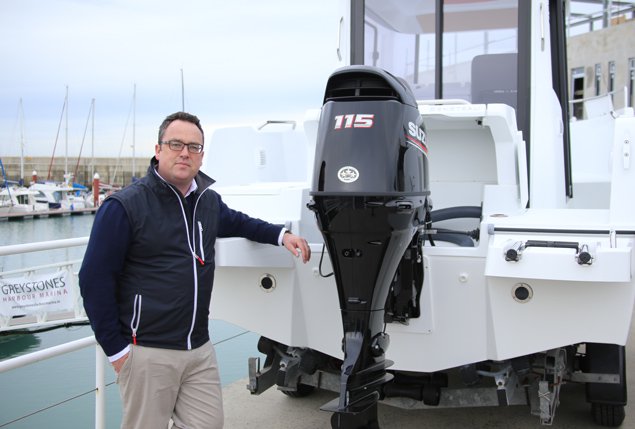 BJ Marine's James Kirwan with one of the new Beneteau Barracuda 6 Sport fishing boats fitted with a 115hp Suzuki outboard engine, now in stock at its Greystones Harbour Marina base Photo: Afloat.ie
BJ Marine's James Kirwan with one of the new Beneteau Barracuda 6 Sport fishing boats fitted with a 115hp Suzuki outboard engine, now in stock at its Greystones Harbour Marina base Photo: Afloat.ie
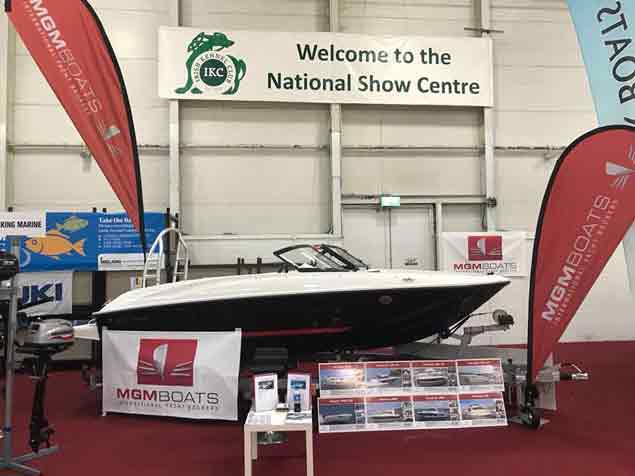 MGM's new Bayliner Element E5
MGM's new Bayliner Element E5
Rival dealer MGM Boats were also at the Show, and they too were debuting a new model of similar size, a multi–use powerboat, the Bayliner Element E5.
There was a strong presence from Suzuki Outboard engines too with its Irish dealer Viking Marine also exhibiting as Afloat.ie reported here.
There has been no Irish Boat show at the traditional RDS venue in nine years and, until now, there has been little demand for same.
Few dealers have been carrying any stock to speak of and the 'marine high street' has been a lot less exotic than it was in, say 2006 at the height of the boom, when Irish Marine Federation members filled the RDS Simmonscourt Halls with over 100 exhibitors in one of the largest ever consumer exhibitions held in Ireland.
'It was great to be exhibiting at a domestic show again, complementing our usual international shows. We had huge numbers on board our Barracuda 6 and people loved the concept of the boat and the range. Plenty to follow up on this week but we would be very confident that there will be more new Beneteau Barracudas in Ireland as a result of the show', BJ Marine's James Kirwan told Afloat.ie
Last weekend in Cloghran may have been a long way from those heady days but from small acorns grow mighty oaks. The hope must be that with an improving economy the Irish marine trade can now get back on its feet after a torrid few years at home.
Beneteau Announces Special Price For Class Members For New Figaro 3 Foiling Yacht
#Figaro - Following this summer’s first images of its new foiling one-design, Beneteau has announced the pricing for the Figaro 3.
And the French marque says it has kept its promise of an affordable boat, with a special price of €155,000 ex VAT for Figaro class members — a discount of €20,000 off the standard retail ticket.
The first 50 Figaro 3 yachts will be delivered in early 2019, with lots drawn to determine the hull numbers at next year’s Nautic Paris Boat Show.


























